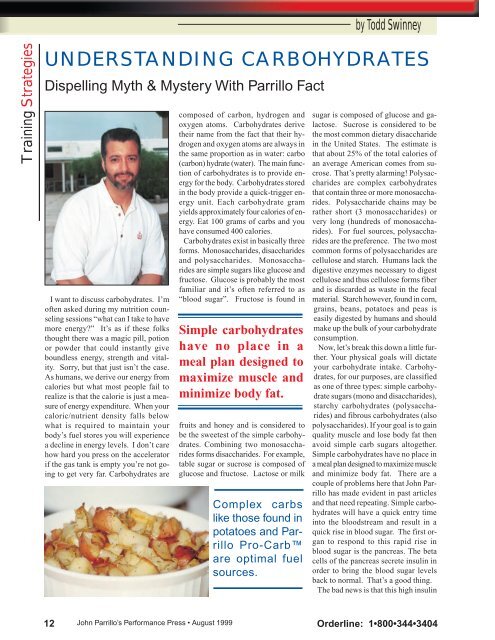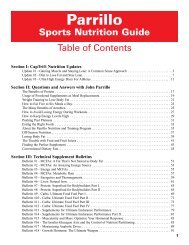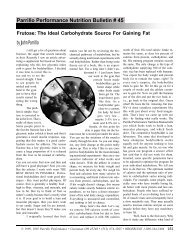A Monthly Magazine For All Bodybuilding, Fitness - Parrillo ...
A Monthly Magazine For All Bodybuilding, Fitness - Parrillo ...
A Monthly Magazine For All Bodybuilding, Fitness - Parrillo ...
Create successful ePaper yourself
Turn your PDF publications into a flip-book with our unique Google optimized e-Paper software.
y Todd Swinney<br />
Training Strategies<br />
UNDERSTANDING CARBOHYDRATES<br />
Dispelling Myth & Mystery With <strong>Parrillo</strong> Fact<br />
I want to discuss carbohydrates. I’m<br />
often asked during my nutrition counseling<br />
sessions “what can I take to have<br />
more energy?” It’s as if these folks<br />
thought there was a magic pill, potion<br />
or powder that could instantly give<br />
boundless energy, strength and vitality.<br />
Sorry, but that just isn’t the case.<br />
As humans, we derive our energy from<br />
calories but what most people fail to<br />
realize is that the calorie is just a measure<br />
of energy expenditure. When your<br />
caloric/nutrient density falls below<br />
what is required to maintain your<br />
body’s fuel stores you will experience<br />
a decline in energy levels. I don’t care<br />
how hard you press on the accelerator<br />
if the gas tank is empty you’re not going<br />
to get very far. Carbohydrates are<br />
composed of carbon, hydrogen and<br />
oxygen atoms. Carbohydrates derive<br />
their name from the fact that their hydrogen<br />
and oxygen atoms are always in<br />
the same proportion as in water: carbo<br />
(carbon) hydrate (water). The main function<br />
of carbohydrates is to provide energy<br />
for the body. Carbohydrates stored<br />
in the body provide a quick-trigger energy<br />
unit. Each carbohydrate gram<br />
yields approximately four calories of energy.<br />
Eat 100 grams of carbs and you<br />
have consumed 400 calories.<br />
Carbohydrates exist in basically three<br />
forms. Monosaccharides, disaccharides<br />
and polysaccharides. Monosaccharides<br />
are simple sugars like glucose and<br />
fructose. Glucose is probably the most<br />
familiar and it’s often referred to as<br />
“blood sugar”. Fructose is found in<br />
Simple carbohydrates<br />
have no place in a<br />
meal plan designed to<br />
maximize muscle and<br />
minimize body fat.<br />
fruits and honey and is considered to<br />
be the sweetest of the simple carbohydrates.<br />
Combining two monosaccharides<br />
forms disaccharides. <strong>For</strong> example,<br />
table sugar or sucrose is composed of<br />
glucose and fructose. Lactose or milk<br />
Complex carbs<br />
like those found in<br />
potatoes and <strong>Parrillo</strong><br />
Pro-Carb<br />
are optimal fuel<br />
sources.<br />
sugar is composed of glucose and galactose.<br />
Sucrose is considered to be<br />
the most common dietary disaccharide<br />
in the United States. The estimate is<br />
that about 25% of the total calories of<br />
an average American comes from sucrose.<br />
That’s pretty alarming! Polysaccharides<br />
are complex carbohydrates<br />
that contain three or more monosaccharides.<br />
Polysaccharide chains may be<br />
rather short (3 monosaccharides) or<br />
very long (hundreds of monosaccharides).<br />
<strong>For</strong> fuel sources, polysaccharides<br />
are the preference. The two most<br />
common forms of polysaccharides are<br />
cellulose and starch. Humans lack the<br />
digestive enzymes necessary to digest<br />
cellulose and thus cellulose forms fiber<br />
and is discarded as waste in the fecal<br />
material. Starch however, found in corn,<br />
grains, beans, potatoes and peas is<br />
easily digested by humans and should<br />
make up the bulk of your carbohydrate<br />
consumption.<br />
Now, let’s break this down a little further.<br />
Your physical goals will dictate<br />
your carbohydrate intake. Carbohydrates,<br />
for our purposes, are classified<br />
as one of three types: simple carbohydrate<br />
sugars (mono and disaccharides),<br />
starchy carbohydrates (polysaccharides)<br />
and fibrous carbohydrates (also<br />
polysaccharides). If your goal is to gain<br />
quality muscle and lose body fat then<br />
avoid simple carb sugars altogether.<br />
Simple carbohydrates have no place in<br />
a meal plan designed to maximize muscle<br />
and minimize body fat. There are a<br />
couple of problems here that John <strong>Parrillo</strong><br />
has made evident in past articles<br />
and that need repeating. Simple carbohydrates<br />
will have a quick entry time<br />
into the bloodstream and result in a<br />
quick rise in blood sugar. The first organ<br />
to respond to this rapid rise in<br />
blood sugar is the pancreas. The beta<br />
cells of the pancreas secrete insulin in<br />
order to bring the blood sugar levels<br />
back to normal. That’s a good thing.<br />
The bad news is that this high insulin<br />
12 John <strong>Parrillo</strong>’s Performance Press • August 1999 Orderline: 1•800•344•3404
















